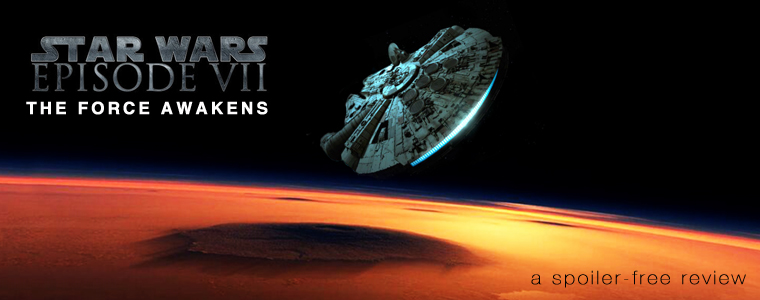EDITOR’S NOTE: To any reader who has not seen The Force Awakens, this review strives to discuss the quality and worthiness of the film in broad strokes, without giving away specific plot points or story revelations. Details mentioned apply only to the earliest set-up elements of the story. Enjoy.
New Millenium, Same Falcon
by Andrew Collins
From its inception, Star Wars: The Force Awakens faced the classic sequel dilemma, but at an unprecedented scale. With the story of one central character — Anakin Skywalker — complete, a whole universe of potential stories and characters stood wide open, directionless and unnecessary, but impossible for the new management under Disney to resist. Expectations were high – muted, perhaps, by the disappointments of the prequel trilogy – but sky high all the same. At the same time, though, the deep-set desire of every person who grew up playing lightsaber battles (among whom this reviewer proudly counts himself) was bent on liking this movie. We all really really wanted The Force Awakens to give us that old escape into a galaxy far, far away.
And that’s exactly what it does.
George Lucas’s original trilogy endures in large part because it is epic in scope. It feels like part of a much wider world, a vast galaxy that turns so many viewers into instant junkies and opens the door for superfans to keep the story alive through a vast trove of expanded universe material. Yet Star Wars is also a deeply personal story, constrained to just a handful of major characters and the deep ties of family and friendship that bind them. Set thirty years after Return of the Jedi, The Force Awakens again takes us to new worlds and resurrects the cosmic, universe-shaking conflict, but it also limits its focus to a small slate of characters. The swashbuckling Han Solo (Harrison Ford) is back at center stage, joined by the gifted orphan Rey (Daisy Ridley) and mutinous stormtrooper Finn (John Boyega). Like Luke, Han, and Leia, these new characters forge deep bonds of friendship and are quick lay their lives on the line for one another.
It’s not hard to see how The Force Awakens recycles the plot points of previous Star Wars films, especially A New Hope. The Resistance (emerging from the old Rebel Alliance) faces the evil First Order (rising from the ashes of the Galactic Empire). A droid carrying secret information flees across a desert planet and fortuitously encounters a gifted orphan who escapes in the Millennium Falcon. X-Wings dogfight with TIE fighters in an attempt to knock out another evil superweapon, our heroes encounter shady characters in a Mos Eisley-like galactic watering hole, and the Millennium Falcon (introduced, much like the first time, as “garbage”) still has the same old gun targeting system, holo-chess board, and Jedi-training remote earlier used by Luke Skywalker. And in a clever inverse of the Luke-Vader trope, a father tries to call his errant son back to the light.
Aside from Finn’s character, there are no unprecedented plot elements of note. Director J.J. Abrams’s conservatism in crafting the film, however, accomplishes something very important: this is how a Star Wars movie is supposed to feel. Where the original trilogy drew from a plethora of cultural sources – Flash Gordon, Vietnam, eastern spirituality, car racing – The Force Awakens draws from, well, Star Wars – as the cultural juggernaut it has become. The result is paradoxically both pleasing and predictable: the movie’s greatest emotional strength is its greatest artistic weakness. Yes, the magic is back, but in the form of pure, undiluted nostalgia. It’s one big mirror of the Star Wars fan’s desires. When Han Solo steps back into the Millennium Falcon, remarks “Chewie, we’re home,” and looks over the cockpit with a smug contentment, memories washing over him, the audience feels it too. It’s been 30 years since we last stepped into the Falcon as well.
It’s quite brilliant, actually, how The Force Awakens ties itself back to the old trilogy. The cinematic experience of the Star Wars opening crawl set to John Williams’s magnificent score is unparalleled, and as the film unfolds it sounds all the right notes, feeling like a natural, believable progression from Return of the Jedi. With the graying hair of Han Solo and the ruins of a Star Destroyer, AT-AT Walker, and X-Wing gracing the landscape of the desert planet Jakku, it steps back into a universe that has aged along with our memories. To Rey and Finn, the battles of the Rebel Alliance and Galactic Empire are legends from a distant past, not unlike the cultural mythology they have become in our current day. Similarly, the new Sith apprentice Kylo Ren (Adam Driver), who wears a helmet and mask that distorts his voice, is a shameless knockoff of Darth Vader. He looks like a Sith is supposed to look, but the film also offers a solid explanation for this.
At the heart of it all is Lucas’s vision of the timeless clash between good and evil, the light side and dark side. The only battle, as the 1,000-year-old Maz Katana (Lupita Nyong’o) reminds us, is the one against the dark side. To join it is evil; to flee from it is cowardice.
Think of The Force Awakens as a remix of a beloved song. Perhaps it lacks pure originality, and any mark it makes in movie history will likely be in record box office sales (not by fundamentally changing how movies are made). But it does not lack adventure, and isn’t that, after all, why we first started going to the movies – to find wonder and suspense and watch good triumph over evil?
After all these years, the sight of X-Wings on the horizon, screaming to the rescue, can still give me chills. And so it should.








